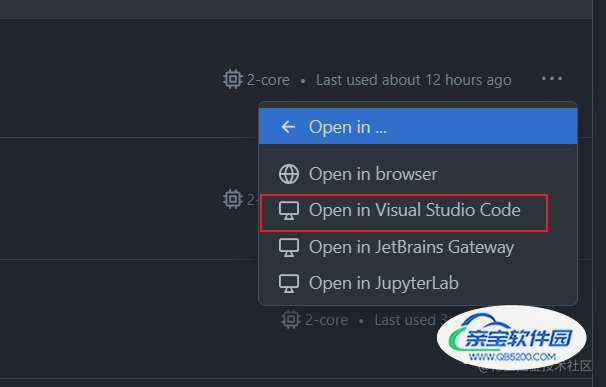JavaScript数据结构yocto queue队列链表代码分析
codeniu 人气:0前言
Yocto-queue 是一种允许高效存储和检索数据的数据结构。它是一种队列类型,是一个元素集合,其中的项被添加到一端并从另一端移除。
它被设计用来操作数据量很大的数组,在你需要使用大量的 Array.push、Array.shift 操作时,Yocto-queue 有更好的性能表现。
仓库地址:sindresorhus/yocto-queue: Tiny queue data structure (github.com)
准备工作
在浏览器中调试代码虽然说很方便但是多多少少看着有点不专业,我们还是使用 Github Workspace,不同的是这次是在本地的vscode中使用。
我们打开 yocto-queue 仓库,创建一个Github Codespace,回到 Github 首页,在导航栏选中 Workspace ,找到你刚创建的项目,选择使用 vscode打开,如图:

vscode 会提示安装Githbu Workspace 插件,实际上它跟 Remote SHH 插件的功能差不多,为我们在远程服务器上开发提供了一种可能,这么做的好处有,跨平台,多端操作,环境统一等。
分析代码
源码如下:
/*
How it works:
`this.#head` is an instance of `Node` which keeps track of its current value and nests another instance of `Node` that keeps the value that comes after it. When a value is provided to `.enqueue()`, the code needs to iterate through `this.#head`, going deeper and deeper to find the last value. However, iterating through every single item is slow. This problem is solved by saving a reference to the last value as `this.#tail` so that it can reference it to add a new value.
*/
class Node {
value;
next;
constructor(value) {
this.value = value;
}
}
export default class Queue {
#head;
#tail;
#size;
constructor() {
this.clear();
}
enqueue(value) {
const node = new Node(value);
if (this.#head) {
this.#tail.next = node;
this.#tail = node;
} else {
this.#head = node;
this.#tail = node;
}
this.#size++;
}
dequeue() {
const current = this.#head;
if (!current) {
return;
}
this.#head = this.#head.next;
this.#size--;
return current.value;
}
clear() {
this.#head = undefined;
this.#tail = undefined;
this.#size = 0;
}
get size() {
return this.#size;
}
* [Symbol.iterator]() {
let current = this.#head;
while (current) {
yield current.value;
current = current.next;
}
}
}
队列
队列是一种先进先出(FIFO)的数据结构,具有以下几个特点:
- 新元素总是添加到队列的末尾。
- 已经在队列中的元素保持原有的顺序不变。
- 任何时候,只能从队列的开头(顶部)删除元素。
入队
enqueue(value) {
const node = new Node(value);
if (this.#head) {
this.#tail.next = node;
this.#tail = node;
} else {
this.#head = node;
this.#tail = node;
}
this.#size++;
}
向队列中添加值。该方法需要一个值作为参数,它用来创建一个新的 Node 对象。
如果队列中已经有一个 head 和 tail 节点,新节点将会添加到队列末尾,通过将 tail 节点的 next 属性设置为新节点,并更新 tail 属性为新节点。
如果队列为空,新节点将成为 head 和 tail 节点。最后,队列的 size 属性会增加以反映新添加的节点。
出队
从队列中删除顶部节点的值,并将其返回。
dequeue() {
const current = this.#head;
if (!current) {
return;
}
this.#head = this.#head.next;
this.#size--;
return current.value;
}
它首先通过检查 head 属性是否为空来检查队列是否为空。如果队列为空,该方法返回 null。如果队列不为空,head 属性将更新为队列中的下一个节点,并且 size 属性减少以反映删除的节点。然后返回原 head 节点的值。
迭代器
允许在 for...of 循环中使用 yocto-queue.
* [Symbol.iterator]() {
let current = this.#head;
while (current) {
yield current.value;
current = current.next;
}
}
使用 Symbol.iterator 符号来为队列定义一个自定义迭代器。迭代器首先将 current 变量设置为队列的 head 属性。然后进入一个循环,只要 current 不为 null 就继续循环。每次迭代,都会使用 yield 关键字产生 current 节点的 value 属性。然后 current 变量将更新为队列中的下一个节点,循环继续。这样 for...of 循环就可以遍历队列中的所有值。
总结
通过阅读yocto-queue的源码,学习到了队列的实现方式,以及迭代器的使用。数组 以及 队列两种数据结构在使用场景上的异同,数组是查询快,插入慢,队列是查询慢,插入快。
加载全部内容